02.04.2007
I.Smykovsky. AEROFLOT OPEN (A Review: Rounds 6-9)
The 6th Aeroflot Open Tournament is over. Now that we know the names of its heroes there is a great temptation to pay all the attention to their creative work forgetting all the other participants. I see no point in trying to completely overcome this desire but will try to be objective and miss nothing. As the reader will presently see, in the end of the tournament even in the games played by the outsiders there was a lot to look into, and this is right, as no sportive setbacks can hamper a chessplayer's creativity. And still I want to begin with the winner. I'd like to seize an opportunity to congratulate Evgeny Alekseev upon his brilliant "double" (I hope that everyone remembers his victory in the Russia championship super final!) and to wish him to keep the gained speed and to show his best on the elite level. WhynotbeginwithDortmund, afterViorelBologan'sexample? The following game which had marked the change of a leader was important in sportive respect. Evgeny's victory was unexpectedly easy. Alekseev (2661) – Novikov (2535) B15 1.e4 g6 2.d4 Ґg7 3.¤c3 c6 4.h3 d5 5.¤f3 ¤f6 6.e5 ¤e4 7.¤xe4 dxe4 8.¤g5 c5 9.Ґc4 O-O 10.c3 cxd4 11.cxd4 ¤c6 12.Ґe3 12...b5?! Strange as it may seem, Black agrees to a discarded variation having nothing serious of his own to offer. Much more interesting is12...Јa5+ 13.ўf1 h6! 14.¤xe4 ¦d8 with counterplay. 13.Ґb3 Ґb7 14.h4! Castling is irrelevant here. 14...Јa5+ 15.ўf1 h5N. To allow 16.h5 is scary, but the move made in the game cannot hamper White's attack as well. 16.g4 ¦ad8. Or 16...hxg4 17.Јxg4 Јa6 18.h5 ¤a5 19.h6!ќ. 17.gxh5 ¤xe5 18.hxg6 ¤f3 (18...¤xg6 19.Јh5ќ) 19.¤xf7. All the rest is, in principle, already not obligatory. 19...¦xf7 20.Ґxf7+ ўf8 21.h5 b4 22.h6 Ґa6+ 23.ўg2 Ґf6 24.h7 ўg7 25.d5 Јc7 26.h8Ј+ ¦xh8 27.¦xh8 ўxh8 28.Јh1+ ¤h4+ 29.Јxh4+! Ґxh4 30.Ґd4+ Ґf6 31.Ґxf6+ exf6 32.¦h1+ ўg7 33.¦h7+ ўf8 34.g7+ 1-0 We will still return to the creative work of the winner, and now let's consider an excellent game played by one of his principal rivals (one can't help recalling the Moscow super final). Playing against Vladimir Akopian Dmitry Jakovenko did not count on an opening, but was seeking for a complex positional struggle in the middlegame. But the crisis came earlier... Jakovenko (2691) – Akopian (2700) C84 1.e4 e5 2.¤f3 ¤c6 3.Ґb5 a6 4.Ґa4 ¤f6 5.O-O Ґe7 6.d3 Jakovenko leaves the beaten track, probably avoiding the discussion in Marshall Counterattack. 6...d6 7.c3 O-O 8.¦e1 b5 9.Ґc2 ¦e8 10.¤bd2 Ґf8 11.¤f1 g6 12.¤g3 Ґg7 13.a4!?N. Previously occurred only 13.h3. 13...b4 14.a5. A typical method. White seizes the room on the Q-side fixing at the same time the a6-pawn and vacating the a4-square for the bishop. 14...bxc3 15.bxc3 ¦b8 16.h3 Ґd7. A crucial moment of the game. Black has covered the a4-e8 diagonal and prepared the rook's lunge to b5. 17.Ґb3! Dmitry does not hamper the opponent's intentions, spreading his own crafty nets. 17...¦b5?! Black does not wish to resign himself to the passive defense. In case of 17...h6 White would choose between 18.d4 and 18.Ґc4, and on 17...Ґe6 there is a good reply 18.Ґa4. 18.Ґa4 ¦xa5? It's been worth it to admit his mistake and to return before it's too late. 19.¦a3! This is just the way in which Jakovenko starts hunting the black rook. There is a threat of 20.Ґxc6, and it turns out now that Black has no adequate defense. 19...¦c5 20.d4. This is more accurate than 20.Ґe3 ¦a5 21.Јc1 ¦xa4 22.¦xa4 ¤d4 23.¦xa6 ¤xf3+ 24.gxf3 Ґxh3. 20...exd4 21.cxd4 ¦b5. Hopeless is 21...¦c4 22.Ґb3 ¦b4 23.e5 dxe5 24.dxe5 ¤h5 25.¤xh5 gxh5 26.Ґxf7+! ўxf7 27.¦d3ќ. 22.Ґxb5 axb5 23.d5. White is an exchange up. All the rest is a matter of simple technique. 23...¤e7 24.Ґb2 b4 25.¦a7 ¤c8 On 25...¤xe4 both 26.¦xe4 Ґxb2 27.¦xb4 Ґf6 28.¦c4ќand 26.Ґxg7 ¤xg3 27.Ґb2 ¤gf5 28.g4ќ look fine. 26.¦b7 ¤b6 27.Јc2 Ґa4 28.Јc1. Surely not 28.Јxc7? Јxc7 29.¦xc7 ¤fxd5. 28...b3 29.Јa1 Ґd7 30.Ґd4 Ґc8 31.¦b8 Јe7 32.¦c1 ¤fd7 33.¦xc8! ¦xc8 34.Ґxg7. White is already a piece up. 34...¦a8 35.Јd4 f5 36.Ґh6 ¦a4 37.Јb2 fxe4 38.¤d2 ¤c5 39.¦xc5! And a little combination for afters. 39...dxc5 40.d6! Јf7 (40...cxd6 41.Јxb3+ќ) 41.dxc7 c4 42.Јe5 ¦a8 43.¤gxe4 ¤d7 44.Јd4 1-0 Vladimir Akopian was not completely successful in this tournament, he had surely counted on a better performance. In the following game which is interesting for the theory of Najdorf Variation Vladimir has been lucky. Akopian (2700) – Najer (2605) B90 1.e4 c5 2.¤f3 d6 3.d4 cxd4 4.¤xd4 ¤f6 5.¤c3 a6 6.Ґe3 e5 7.¤b3 Ґe6 8.f3 Ґe7 9.Јd2 O-O 10.O-O-O ¤bd7 11.g4 Јc7 12.g5 ¤h5 13.ўb1 b5 14.¤d5 Ґxd5 15.exd5 ¤b6 16.¤a5 ¤xd5 17.Јxd5 Јxa5 18.c4 ¦ab8 19.Ґd3 19...Јd8!? More popular are 19...Јa4 and 19...Јb4. The move chosen by Najer seems none the worse. The g5-pawn is under attack now. 20.¦hg1 bxc4 21.Ґxc4 a5 22.¦c1N. In the recent computer game there occurred 22.¦g2. 22...Јd7!? A cool decision. Black exchanges the a5-pawn for its f3-counterpart without being concerned about the f-file opening-up. 23.Јxa5 Јf5+ 24.ўa1 Јxf3 25.Јd2 ¤f4 26.¦gf1 Јh5 27.Ґxf4 exf4 28.h4! Vladimir Akopian offers the whole K-side phalanx. 28...Јxh4 29.g6! hxg6 30.¦h1 Јg5? Up to this moment Black has been irreproachable, but his very first mistake becomes fateful. He should have played 30...Јg4! 31.¦cg1 (if 31.¦h2, then 31...Ґh4! intercepting the dangerous file, and after 31.Јh2 Јh5 nothing is gained by 32.Јxf4? because of 32...Ґg5!) 31...Јf5 32.Јh2 Јh5 33.Јd2 (33.Јxf4 Ґf6! 34.Јxf6 Јxh1) 33...Јf5, and I can see no better outcome for White than the move repetition. 31.¦h2. There is no adequate defense from mate. 31...¦xb2 32.¦ch1! ¦xa2+ 33.ўxa2 ¦a8+ 34.ўb3 ¦b8+ 35.ўc2 Јf5+ 36.Јd3 1-0 Let us continue the subject of offense and defense, and incidentally proceed to the last year's winner Baadur Jobava's creative work. Georgian GM played very actively, was ready for great struggle and didn't mind taking chances. Jobava (2650) – Ehlvest (2610) 25.f5!? Baadur Jobava sets about assaulting his opponent's kingly bastions. The alternative is 25.Ґxe7. 25...b4 26.f6 gxf6! After 26...Ґxf6 27.Ґxf6 ¦b7 28.Ґe5 bxc3 29.Јe3! Black loses the c3-pawn. 27.Јe3 27...ўh7? 27...ўg7? also leads to defeat in view of spectacular 28.Ґxf6+! Ґxf6 29.¦xf6! ўxf6 30.Јxh6+ ўe7 31.¦d1! – there is a threat of 32.Јg7#, and on 31...¦f8 the issue is decided by 32.¤d5+ќ. It does not help any to play 27...Ґb7? hoping for a perpetual check after 28.Јxh6 bxc3 – White wins with some quiet moves: 29.Јg6+ ўh8 30.¦be1! ¦f8 31.Јh6+ ўg8 32.g5! (threatens 33.g6 and 33.gxf6) 32...fxg5 33.Јg6+ ўh8 34.¦g1! e5 (34...¦f5 35.Јh6+ ўg8 36.Ґxg5 Јxe4+ 37.¦xe4 Ґxe4+ 38.ўh2 ¦f2+ 39.ўg3 ¦f3+ 40.ўh4 ¦f4+ 41.¦g4ќ) 35.Јh5+ ўg7 36.Ґxg5 Јxe4+ 37.¦xe4 Ґxe4+ 38.ўh2 ¦f2+ 39.ўg3 ¦f3+ 40.ўh4 ¦f4+ 41.¦g4 ¦h8 42.Ґf6+!ќ. The strongest continuation is 27...¦b7! defending the rook and preparing to enter it in the game along the 7th rank when the opportunity presents itself. Then it is possible to play 28.¤e2 (bad for White is 28.Ґxf6? bxc3 or 28.Јxh6? Ґf8 29.Јg6+ ¦g7 30.Јh5 bxc3) 28...f5 29.Ґxe7 ¦bxe7 30.¤g3 Ґb7, and all the struggle is still ahead. 28.Ґxf6 Ґb7?! More stubborn is 28...Ґd6, after which White has to find 29.ўg1! (preparing 30.e5 with the following check along the b1-h7 diagonal) 29...Ґb7 (after 29...bxc3 30.e5! ¦g8 31.Јd3+ ¦g6 32.¦xb8 Ґxb8 33.Јd8 ¦g8 34.Јe7+ ўg6 35.Ґg5! Black is mated) 30.Јd3! ¦g8 (Absolutely hopeless is 30...e5 31.¤d5ќ) 31.¤d5 ¦g6 32.Ґb2! exd5 33.¦f7+ ўg8 34.exd5 Ґh2+ 35.ўh1! Јd6 (after 35...Јb6 36.Јf5 Black is defenseless – there is a threat of 37.¦h7, 37.¦xb7 and just plain 37.¦bf1) 36.¦d7! with a win. 29.Ґe5 ўg6 30.¦f7! Black resigned in view of 30...ўxf7 31.Јxh6 ¦g8 32.Јh7+.1-0 Aleksandrov (2601) – Jobava (2650) D31 1.d4 d5 2.c4 e6 3.¤c3 Ґe7 4.cxd5 exd5 5.Ґf4 c6 6.Јc2 ¤f6 7.e3 ¤bd7 8.Ґd3 ¤h5 9.Ґg3 g6 10.O-O-O O-O 11.¤f3 ¤xg3 12.hxg3 Ґf6N. The bishop is immediately transferred to the long diagonal. In the game between little known chessplayers Black has chosen 12...¦e8. 13.e4!? A logical advance in the center, as white pieces are placed actively 13...Ґg7! Provoking the opponent to grab a central pawn. 14.exd5. This is surely principled, but I am not sure that it is a good move. At least Black has taken over the initiative after it. More reliable is to retain the closed nature of the position by way of 14.e5, and then White can step up the pressure on the K-side by transferring the knight from c3 to f4 and doubling the rooks along the h-file. 14...cxd5 15.¤xd5. And here it is worth it to consider the calm move15.¦de1 15...¤b6! After opening up in the center two bishops are ready to show their worth at full scale. 16.¤f4?! Preventing 16...Ґe6 but moving too far away from its own king. Stronger is16.¤c7!? ¦b8 17.¤e5 Ґg4!? 18.¤xg4 ¦c8 19.ўb1 ¦xc7 20.Јb3 ¦d7 with rough equality, or simply 16.¤c3. 16...Ґd7 17.ўb1 ¦c8 18.Јd2 (18.Јb3? Ґa4) 18...¤c4 19.Ґxc4 ¦xc4 20.¦c1 20...¦a4! No exchanges whatsoever! The compensation for the sacrificed pawn is more than adequate now. 21.¦c5 Ґc6 22.Јc2. On 22.d5?! there is a reply 22...Јb6! in store, and if 23.¦hc1?, then 23...Ґxb2! 24.Јxb2 ¦b4. 22...Јd6 23.¤e2?! The knight returns, but it takes time. Better is 23.¦d1 not being concerned for 23...Ґe4?! 24.Јxe4 Јxc5 because of 25.¤e6! Јb5 (25...Јe7 26.Јc2) 26.¤xf8 ¦xa2 27.ўxa2 Јa4+ 28.ўb1 Јxd1+ 29.ўa2 Јa4+ with perpetual check. Of course, Black can play 23...¦e8 24.a3 Ґe4, but after 25.¤d3 White stands solidly enough. 23...¦e8 24.¤c3? After that move it is extremely difficult to save the game. White has problems everywhere, but in case of 24.ўa1or even clumsy 24.¦h4 Ґf6 25.¦f4 there is still no absolute clarity. 24...¦xd4! Jobava has precisely calculated the consequences of this blow. 25.¤b5?! More stubborn is 25.¤xd4 Јxc5 26.¤xc6 Јxc6 or 25.¦xc6 Јxc6 26.¤xd4 Ґxd4, although it would have hardly changed the result. 25...Јd7! There is a threat of 26...Ґe4. 26.¦xc6 ¦b4! 27.¦c3. On 27.¦c7 Јxb5 28.b3 the simplest way is 28...¦be4!°. 27...Јxb5 28.¦b3 ¦xb3 29.axb3 ¦e2 30.Јc8+ Ґf8 31.¤d4 Јd3+ 32.¤c2 ¦xf2 33.¦c1 Јxb3 34.¦e1 ¦xg2 0-1 The following battle had determined the results of the tournament to a large extent. Both Baadur Jobava and the hero of the start Evgeny Tomashevsky could have been successful, and, as it frequently happens, the game ended in a draw, so that every one of them can now regret the missed opportunities. Jobava (2650) – Tomashevsky (2624) A39 1.¤f3 ¤f6 2.c4 c5 3.¤c3 ¤c6 4.g3 g6 5.Ґg2 Ґg7 6.d4 cxd4 7.¤xd4 O-O 8.O-O ¤xd4 9.Јxd4 d6 10.Јd3 a6 11.Ґe3 ¤g4 12.Ґd4 ¤e5 13.Јd1 Ґe6?! A disputable pawn sacrifice. From the point of view of struggling for equality more reliable is13...¦b8. 14.Ґxb7 ¦b8 15.Ґxa6 ¦xb2 16.¤d5 ¦b8 17.a4 17...Ґh3!N. Much more interesting than 17...Ґh6 18.¦b1 Јd7 19.Ґb5± (Vukic – Gufeld, Odessa 1975). 18.¦e1 g5!? An original treatment. Now Black constricts the d5-knight. 19.Ґb5 e6 20.¤b4 Јe7. The queen strives for getting to b7. With the same object 20...Јc7!? is worth attention. 21.Ґxe5 Ґxe5 22.¤c6 Јb7 23.¦a3!? A surprising resource – there is a threat of 24.g4!, but perhaps still better is 23.a5 Ґxa1 24.Јxa1 ¦fc8 25.Јa4© with strong initiative. 23...¦fc8 24.g4! ¦xc6! 24...Ґxg4?! 25.¤xe5 dxe5 26.¦g3± is in favor of White, so an exchange sacrifice is necessary. 25.Ґxc6 Јxc6 26.¦xh3 Јxc4 27.Јd3. While the rook is posted on h3 the wish to examine 27.f3 is somehow vanishes. 27...Јxg4+ 28.ўh1. There ensued the complex position. Black has a compensation for an exchange, but is it adequate? If White plays correctly that is not so. 28...ўf8. Risky is 28...f5 29.¦g1 Јf4 30.Јc2±. 29.¦xh7 Јf4 30.ўg2 ¦c8 (30...Јxa4? 31.¦h8+!) 31.¦b1 ўg8 32.a5?! It was not worth it to hurry with that pawn advance. Stronger is 32.¦h3! g4 (32...f5 33.Јe3 g4 34.¦h6±; 32...Јxa4 33.Јh7+ ўf8 34.¦f3±) 33.Јh7+ ўf8 34.¦h5±. 32...f5 33.¦h3 ¦c3! Hard times are past for Black. 34.¦b8+ ўg7 35.¦b7+. 35.Јxc3?! Ґxc3 36.¦xc3 Јe4+ is dangerous for White only. 35...ўg6 36.Јb5 ¦c8. With this kind of play any outcome is possible. 37.Јb4? Now it's White who has to watch out. Losing is 37.a6? g4 38.¦g3 Ґd4! 39.f3 Јe3°. It should be played 37.¦e7 ўf6 38.¦eh7! (38.Јb7 Јg4+ 39.¦g3 Јe4+=) 38...Јg4+ 39.¦g3 Ґxg3 40.hxg3І with minimal advantage, or 37.Јb3 – just the way White will play in a couple of moves. 37...¦c4? Winning is 37...Ґd4! 38.¦f3 Јg4+ 39.¦g3 Јe4+ 40.¦f3 (40.f3 Јe3) 40...g4°. 38.Јb5 ¦c8 39.Јb3 Јe4+ 40.¦f3 ¦c4 41.Јb1?! 41...g4 is not so terrible a threat. One can play 41.a6! Јc6! 42.¦b4 ¦xb4 43.Јxb4 Јxa6 44.Јb3І. 41...Јh4 [41...Јc6!? 42.¦b6 (42.h3 g4 43.hxg4 ¦xg4+=) 42...¦g4+ 43.ўh1 Јc4›] 42.¦h3!? White tries to find some chances. To an immediate draw leads 42.¦g3 Ґxg3 43.hxg3 Јe4+=. 42...Јg4+ 43.¦g3 Ґxg3 (43...Јxe2? 44.Јd3±) 44.f3! Јd4 45.hxg3 Јe5 46.Јa2 (46.Јb2 Јxb2 47.¦xb2 ¦a4=) 46...¦a4. After 47.Јxa4 Јxe2+ there is a perpetual check, so the opponents agreed to a draw. Ѕ-Ѕ Novelties in Zaitsev Variation of Ruy Lopez frequently crop up after the move 20, just the way it occurred in the following baffling game, which has not been easy to sort out at all. Kotronias (2572) – Bologan (2658) C92 1.e4 e5 2.¤f3 ¤c6 3.Ґb5 a6 4.Ґa4 ¤f6 5.O-O Ґe7 6.¦e1 b5 7.Ґb3 d6 8.c3 O-O 9.h3 Ґb7 10.d4 ¦e8 11.¤bd2 Ґf8 12.a4 h6 13.Ґc2 exd4 14.cxd4 ¤b4 15.Ґb1 c5 16.d5 ¤d7 17.¦a3 c4 18.axb5 axb5 19.¤d4 Јb6 20.¤f5 ¤e5 21.¦g3 g6 22.¤f3 ¤ed3 23.Ґe3. In the well-known game Anand – Adams(San Luis 2005) White had won by way of 23.Јd2!?, but the following analysis showed that the game should have ended in a draw. 23...Јd8 24.Ґxh6 Јf6 25.Јd2!N. Previously occurred only favorable for Black 25.¦e2 and 25.Ґxf8. 25...¤xe1. The most principled continuation. Bad is 25...¦xe4? 26.¦xe4 Јxf5 27.Ґxf8 ¦xf8 28.¦e7±. The alternative is 25...Ґc8!? seeking to exchange the active f5-knight, and after 26.Ґxf8 ¦xf8› there ensues an absolutely unclear position. 26.¤h2? After this move Black takes over the initiative. Stronger is 26.Ґxf8!, on which Black should answer 26...¤xf3+! Every other move is losing: 26...¦xf8? 27.¤h2! Јh8 28.¤g4 ¦fd8 29.Јg5! ¦e8 30.¤gh6+ ўf8 31.¤xf7 Јh7 32.¤7xd6 ¤xd5 33.exd5 Ґxd5 34.Јf6+ Ґf7 35.¤xf7 Јxf7 36.Јd6+ќ or 28...¦fe8 29.¤gh6+ ўf8 30.Јxb4 ¦e7 31.¤xe7 ўxe7 32.e5! Јxh6 33.Јxd6+ ўe8 34.e6ќ; 26...ўxf8? 27.Јh6+ ўg8 28.¤3h4! Јh8 29.¦xg6+! fxg6 30.Јxg6+ ўf8 31.Јxd6+ ўg8 (31...ўf7 32.¤h6+ Јxh6 33.Јxh6 ¦a1 34.¤f5ќ) 32.Јg3+ ўf7 33.¤d6+ ўf6 34.Јf4+ ўe7 35.¤g6+ќ; 26...¦a1? 27.Ґg7! ¤xf3+ 28.¦xf3 ¦xb1+ 29.ўh2 Јxf5 30.exf5ќ. After 26...¤xf3+! 27.¦xf3 ўxf8! (this is stronger than 27...gxf5 28.¦xf5 Јg6 29.¦g5 Јxg5! 30.Јxg5+ ўxf8 31.Јh6+ ўg8 32.e5 ¤d3!, and here White, having a perpetual check at hand, can play for a win after 33.f4! with a powerful threat of f4-f5-f6) 28.¤h6 Јg7 (28...Јxf3? 29.gxf3 ¤xd5 30.exd5 ¦a1 31.Јc1 Ґxd5 32.ўg2 ¦e5 33.¤g4 ¦e6 34.Јh6+ ўg8 35.Ґe4ќ) 29.¦xf7+ Јxf7 30.¤xf7 ўxf7 31.Јxb4 ¦a1 32.Јxd6 (32.f3 ¦xb1+ 33.ўh2; 32.Јe1 Ґxd5 33.f3 Ґe6) 32...¦xb1+ 33.ўh2 ¦xe4 34.Јc7+ ¦e7 35.Јf4+ ўg7= there is equality on the board. 26...¦xe4! The most humanly continuation. Giving back the extra rook Black prevents knight's joining in the attack from the g4-square, making it stand on f1. Most dangerous is 26...¤ed3?! 27.¤g4 Јxb2 28.Јg5! with crushing white attack. 27.Ґxe4 ¦a1 28.¤f1 Ґxd5! 29.Ґxd5. Bad is 29.Ґxf8? Ґxe4 30.Ґg7 Јxf5 31.Јh6 because of 31...Јh5! 32.Јxh5 gxh5 33.Ґc3+ ўh7°. 29...Јxf5 30.Ґxf7+! Less strong is 30.Ґxf8? Јxd5 31.Јxd5 (in case of 31.Јc3 ўxf8 32.Јh8+ ўe7 33.¦e3+ ўd7 34.Јe8+ ўc7 35.¦e7+ ўb6° black king escapes from checks) 31...¤xd5µ. 30...ўxf7 31.Ґxf8 ¤bd3! 32.Јh6! After 32.Ґh6 Јe4! there is a very unpleasant threat of 33...Јxg2+! 32...Јxf2+ 33.ўh2 Јf6! (33...Јxb2? 34.Јxg6+ ўxf8 35.Јxd6+ ўf7 36.Јd7+ ўf6 37.¤e3!ќ) 34.¤e3? In was necessary to play 34.¤d2!, and after 34...g5! (34...Јe5 35.¤e4! Јxe4 36.Ґxd6 ¤e5 37.Јf8+ ўe6 38.Ґxe5 Јxe5 39.Јe8+=) 35.Јxf6+ ўxf6 36.¤e4+ White retains drawing chances. 34...¤f2? A mistake after which the position estimate changes to the opposite. Winning is 34...¤e5! 35.¤g4 ¤xg4+ 36.¦xg4 ¤d3 37.¦e4 ¦h1+! 38.ўxh1 ¤f2+°. 35.¤c2? And now it is a computer variation 35.Ґe7!! Јg7 36.Јf4+ ўe8 (36...ўxe7 37.¤f5+; 36...ўg8 37.Јxf2ќ) 37.Јxf2 Јxe7 38.¤xc4!ќ that leads to White's win. 35...¤xc2 36.¦f3 ¦h1+ 37.ўg3 ¤e4+ 38.ўg4 38...¦f1!? An interesting attempt to play for a win. After 38...¤f2+ 39.¦xf2 Јxf2 40.Јg7+ ўe6 41.Јe7+ ўd5 42.Јxd6+ ўe4 43.Јxg6+ ўd5 44.Јd6+ everything would have ended up in a perpetual check. 39.¦xf6+ ¦xf6 40.Јg7+? An erroneous decision, after which it becomes extremely difficult to save the game. White on his own free will drives black king forward where it is going to help its passed pawns. It should have been played 40.Ґg7 ¦f5 41.Ґh8! ¦g5+ 42.ўf3 ¦f5+=. 40...ўe6 41.Јe7+ ўd5 42.Ґh6. On 42.Јb7+ ўd4 43.Ґg7 ¤e3+ 44.ўh4 ¤xg2+ 45.ўg4 ¤e3+ 46.ўh4 there follows a fantastic move 46...ўe5!! 47.Ґxf6+ ўf4! 48.Јxe4+ ўxe4°. 42...¦f2 43.Јb7+ (43.g3 ўd4 44.Јg7+ ўd3 45.Јxg6 ¤d4 46.h4 ¦xb2 47.h5 c3 48.Ґf4 ¤e2 49.ўf3 d5 50.Ґe5 ¦b1 51.h6 c2 52.h7 c1Ј 53.h8ЈЈe3+ 54.ўg4 ¤d4°) 43...ўd4 44.g3 ¤e3+ 45.Ґxe3+ ўxe3 46.Јa7+. Losing is 46.Јxb5 ¤f6+ 47.ўg5 ¦f5+ 48.Јxf5 gxf5 49.ўxf6 d5 50.h4 d4°. 46...ўd3 47.Јa3+ ўe2 48.Јa8 48...d5! Strong passed pawns and bad position of the white king determine Black's decisive advantage. 49.Јe8 ¦f3 50.h4 b4. The quicker way to achieve his goal is 50...ўe3! 51.ўh3 ўf2 52.ўh2 ¤d2!°. 51.ўh3¦xg3+ 52.ўh2 c3 53.bxc3 bxc3 54.h5c2 55.Јb5+ ¦d3 0-1 And now a relatively simple episode. Arkadij Naiditsch has more than enough reasons to complain of the missed "goal chances" in this tournament... Naiditsch (2663) – Shomoev (2556) 29.¦c8+ ўg7 30.¤a4 Јa7. After 30...¤e5 31.¤xb6 ¤f3+ 32.ўg2 ¤xd2 33.¦c6! ¦d8 34.¤f5+ ўg6 35.¤c8! ¤de4 36.¤cd6 ¤xd6 37.¤xd6 ўg7 38.ўf3 a5 39.¦a6± White obtains an endgame with an extra pawn and good chances to win. 31.Јf2 There is a deadly threat of 32.¤f5+. Still a tactical trick permits Black to escape the scrape. 31...¦h1+! 32.ўxh1 Јb7+ 33.ўg1 Јxc8 34.¤f5+ ўf8? This is the most natural move... and a decisive mistake. Of course, Black wouldn't like to play 34...ўh8 permitting a check from h2, but after 35.Јh2+ ¤h7 36.Јh6 Јf8 37.Јxa6 ¤hf6 38.Јe2 Јb4= he wins back a pawn, and the position becomes level. 35.¤b6? "An amnesty". To the win leads 35.Јh2! ¤g8 36.Јh8ќ. White wins a knight, and the attempt to obtain a perpetual check after 36...Јd8 37.Јg7+ ўe8 38.Јxg8+ ¤f8 is stopped by 39.¤c3! 35...Јc5 36.¤xd7+ ¤xd7 37.Јxc5+ ¤xc538.ўf2 ¤d7 39.b4 ¤e5 40.ўg3 ўe8 41.¤d6+ ўe7 42.¤e4 ¤c6 43.c3 f6 44.¤c5 a5 45.bxa5 ¤xa5 46.ўf3 ўd6 47.¤d3 Ѕ:Ѕ Young Chinese chessplayer Zhou Jianciao carried out a fine attack. Gashimov (2658) – Zhou Jianciao (2551) 24...f5! Black is down a pawn, so he has to act energetically. 25.exf5?! Was it worth it to permit the bishop being set up on the long diagonal? Much more reliable is 25.¦e1 fxe4 26.¦xe4. 25...Ґf6 26.fxe6+ fxe6 27.¦h3? A decisive mistake. Of no help is 27.¦hd1? d5 28.f5 Ґxc3 29.Јa7+ ¦b7 30.fxe6+ ўe8°.White should have looked for his chances after 27.Јh5 Ґxc3 28.Јf7+ (28.¦hd1 ¦c7!) 28...ўd8 29.Јxe6 Ґb4! (weaker is 29...ўc7?! 30.Јe7+ ўb6 31.¦xd6 ¦a8 32.¦xc6+ ¦xc6 33.Јe3+=), although a piece here is stronger than pawns. 27...Јxc3! A spectacular move accurately calculated by Chinese player. 28.¦xh7+. If 28.¦xc3, then 28...Ґxc3 29.Јa7+ ўe8 30.Јe3 (30.¦e1 ¦a8 31.¦xe6+ ўf8 32.Јe7+ ўg8 33.¦g6+ ўh8°) 30...¦a8! 31.Јxe6+ ўf8 32.Јxd6+ ўg8 33.Јd5+ ўh8°. 28...ўe8 29.Јxc3 Ґxc3. The endgame is easily won for Black. 30.¦a7 ¦a8 31.¦a4 ¦xa4 32.bxa4 ¦c4 33.ўa2 ¦xf4 34.ўb3 Ґa5 35.h4 ўf7 36.h5 ўg7 37.¦h3 ¦b4+ 38.ўa3 ¦g4 39.¦b3 ўh6 40.¦b5 ¦g3+ 41.ўa2 ¦g5 42.g4 ¦xb5 43.axb5 e5 44.ўb3 d5 45.c3 e4 46.ўc2 ўg5 0-1 The next example applies to the subject "Attack by small force". Igor Lysyj had literally squeezed his pieces dry, making the most of his material. Lysyj (2576) – Ehlvest (2610) White stands menacingly, but does he have resources enough to get to black king? There are no queens on the board already, and Black begins his own counterplay on the Q-side. 30.Ґe2! Igor Lysyj gets down to a decisive and non-trivial restructuring of his forces without paying any attention to the opposite side of the board. 30...bxa4 31.Ґd3! axb3 32.¦g8+ ўh7 33.¤f2! ¦a7 34.¤g4! Black is two pawns up, but he is practically helpless. 34...Ґc8 35.¦g3! The last one in the series of smooth moves. 35...¦ae7?! Also losing is 35...a5?! 36.¤xh6! a4 37.¦h3 ¦fe7 38.¦g1ќ, but more stubborn is 35...b2! 36.¤xh6! ¦fe7! (36...¦fb7 37.¦xf8 b1Ј+ 38.Ґxb1 ¦xb1+ 39.ўg2 ўxh6 40.¦xe8ќ) 37.¤xf5 ¦e1+ 38.ўg2 b1Ј 39.Ґxb1 ¦xb1 40.¦xf8 – White is a pawn up and have excellent prospects for a win. 36.¤xh6! ¤f6. To an inevitable checkmate leads 36...ўxh6 37.¦h3ќ, and in case of 36...a5 there follows 37.¦8g5! ўh8 38.¦h3ќ, and Black cannot post any piece on h7. 37.¦8g5 ¤e4 38.Ґxe4 ўxh6 (38...fxe4 39.¤xf7 ¦xf7 40.¦xb3ќ) 39.¤f6! 1-0 Alexander Areshchenko had methodically and unhurriedly prepared the decisive storm against Aleksej Aleksandrov. I have to admit that I am not sure even now as to where Black has made his mistakes. Areshchenko (2644) – Aleksandrov (2601) C54 1.e4 e5 2.¤f3 ¤c6 3.Ґc4 Ґc5 4.c3 ¤f6 5.d3 a6 6.Ґb3 Ґa7 7.O-Od6 8.¤bd2 O-O 9.h3 Ґe6 10.¦e1 ¦e8 11.¤f1 h6 12.¤g3 Јd7 13.Ґc2 d5 14.Јe2 ¦ad8 15.ўh2 15...ўh8?!N. Black prepares knight's retreat to g8. This idea is somewhat passive and sluggish, but it has been already employed in Aleksandrov's practice. More logical is15...b5 in order to carry out d5-d4 and then after an exchange on c3 to play b5-b4 occupying the central square. By the way, if White plays ¤h4 and Јf3, then, considering the knight on f6, he will have to take into account a tactical lunge ¤g4+. 16.¤h4 ¤g8 17.Јf3 Ґc5 18.¤gf5 Ґf8 19.g4 g6. Black's hope to drive back the strong knight did not come true. 20.¦g1! dxe4 21.dxe4 gxf5?! This move is associated with great and very likely unjustified risk. If the capture is denied, then White would have entered into play his Q-side resources. 22.gxf5 Ґc4 23.f6! It is hard to overestimate the role of this pawn. 23...¦e6. Asking his opponent for an immediate blow to g8 which has been successfully carried out. It is not so easy to propose anything better for Black. After neutral replies White would develop his bishop on e3 at first. Bad is 23...Јd6? 24.¦xg8+ ўxg8 25.Ґe3 ўh8 26.¦g1 Ґe7 (26...¤e7 27.fxe7 Ґxe7 28.¤f5 Јe6 29.Ґxh6ќ) 27.¤f5 Јxf6 28.Ґxh6 Јg6 (28...¦g8 29.Јh5ќ) 29.¦xg6 fxg6 30.Јg3 ўh7 31.¤xe7 ¤xe7 32.Ґg5ќ, and in case of 23...Јe6 24.b3!± the b5-bishop becomes constricted. 24.¦xg8+! ўxg8 25.Ґe3 ¤e7?! Not very comforting, but still more stubborn is 25...¦xf6 26.Јxf6 Јe6 27.¦g1+ ўh7 28.Јf3±. 26.fxe7 Ґxe7 27.¦g1+ Ґg5. None the better is 27...ўf8 28.¤f5! Јb5 29.b3 Ґe2 30.¤xh6! Ґf6 (30...ўe8 31.Јxf7+ ўd7 32.¦g7ќ) 31.Јf5 ўe7 32.¤xf7!ќ. 28.Јh5 ¦f6.If 28...f6, then 29.b3 Ґb5 30.Јxh6 Јg7 31.¦xg5!ќ. 29.b3! An important inclusion. Now the c4-bishop has no comfortable moves. 29...Ґb5 [29...Ґd3 30.Ґxd3 Јxd3 31.¦xg5+! hxg5 32.Јxg5+ ¦g6 33.¤xg6 fxg6 34.Јxg6+ ўf8 (34...ўh8 35.Ґg5ќ) 35.Ґh6+ ўe7 36.Ґg5+ќ;29...Ґe6 30.¦xg5+! hxg5 31.Јxg5+ ¦g6 32.¤xg6 fxg6 33.Јxg6+ќ] 30.a4 Ґc6 31.¦xg5+! hxg5 32.Јxg5+ ¦g6 33.¤xg6 fxg6 34.b4! The light-squared bishop's entering in the game turns out to be decisive. 34...¦e8 35.Ґb3+ ўh8 36.Јh4+ Јh7 37.Ґh6! The final subtlety. This alternation of sacrifices and quiet moves really impresses. 37...¦f8 38.Јg5 ¦xf2+ 39.ўg3 ¦f7 40.Јxe5+ ¦g7 41.Јg5 Ґe8. Or 41...¦f7 42.b5 axb5 43.axb5 Ґd7 44.Јe5+ ¦g7 (44...ўg8 45.Јe7!ќ) 45.Ґxg7+ Јxg7 46.Јxc7ќ. 42.Ґxg7+ Јxg7 43.Јh4+ Јh7 44.Јf6+ Јg7 45.e5 g5 46.a5 Јxf6 47.exf6 Ґd7 48.Ґd5 Ґc8 49.Ґf3 b6 50.Ґg4 Ґb7 51.Ґf5. The endgame is absolutely hopeless for Black, so he resigned. 1-0 We begin to get used to the successes of Chinese players. This year two of them have reached the "+4"-level, and that tells volumes. Ni Hua (2632) – Minasian (2595) Black has carried out a breakthrough on the Q-side and is ready to begin "reaping the harvest". Chinese chessplayer makes a decision to press on regardless. 30.g5!? ¤xf5. There is no other way: 30...fxg5? 31.fxe6 ¦xf2 32.exd7 ¦xf1+ 33.¦xf1ќ;30...hxg5 31.¤g6+ Ґxg6 32.hxg6 ¤g8 33.¤g4 exf5 34.Јh2+ ¤h6 35.¤xh6 gxh6 36.Јxh6+ ўg8 37.¦xf5! Јg7 38.Јh5 ¦b6 39.¦df1ќ. 31.g6 ¤xh4. Black could have faced the future confidently after 31...Ґg8! 32.exf6 (32.¤hxf5 exf5 33.¤xf5 fxe5 34.dxe5 ¦xc3) 32...¦xf6 33.¤g4 ¦f8 34.¤e5 Јe7. 32.Јxh4 ¦xc3. And here is quite an interesting variation 32...f5!? (the light-colored bishop is no great shakes anyway) 33.gxh7 ¦xc3›. 33.exf6 (33.Јe1?! ¦xa3 34.gxh7 f5µ) 33...gxf6 (33...¦xe3? 34.Јf4ќ) 34.¦xf6 ¦xf6 35.Јxf6+ Јg7 36.Јf4 36...Ґg8? The tension of the struggle has reached a high enough degree, and Black makes a mistake. It is difficult for him to play with the bishop posted on g8. The right way is 36...¦xa3!, and if 37.¤g4, then he might think over 37...Ґxg6!? 37.¤g4 ¦xa3 38.¤xh6 ¦h3 39.Јg5? White returns the compliment. Winning is 39.¤xg8! ¦xh5 (39...ўxg8 40.¦f1 ¦b3 41.¦f2! with a decisive threat of 42.h6) 40.Јg4 ¦f5 41.¦b1! ўxg8 (41...Јxg8 42.¦b7ќ; 41...¦f8 42.¦b2ќ) 42.¦b8+ ¦f8 43.Јxe6+ ўh8 44.Јh3+ ўg8 45.Јh7+ќ. 39...¦d3? Artashes Minasian misses his chance. Losing is 39...a4? 40.ўg2! ¦b3 41.¤f5! exf5 42.h6ќ and 39...c3 40.ўg2 c2 41.¦f1 ¦c3 42.¤f7+ Ґxf7 43.¦xf7 ¦c8 (43...c1Ј 44.Јd8+ Јg8 45.¦h7#) 44.¦xg7 c1Ј 45.¦h7+ ўg8 46.¦h8+, butBlackhasachoice: 39...Јc7 40.Јf6+ Јg7 41.¤xg8 ¦xh5 42.Јxg7+ ўxg7 43.¤e7 ўf6, or 39...¦f3!? 40.¤xg8 (40.ўg2 Јf6 41.Јxf6+ ¦xf6 42.¦a1 ўg7 43.¤xg8 ўxg8 44.¦xa5 ¦f5=) 40...ўxg8 41.Јg4 ¦f5 42.¦b1 Јc7 . In both cases the struggle goes on. 40.¦xd3 cxd3 41.ўg2! The king escapes the check, depriving Black of his last hope to display activity. 41...Јf8 (41...Јxd4 42.¤f7+ Ґxf7 43.Јh6+ ўg8 44.Јh7+ ўf8 45.Јxf7#) 42.¤g4 Ґh7 43.¤e5 1-0 If Ni Hua has already established himself, then the success of quite a young player Wang Yue was sensational. I'd like to give here two of his games without seriously analyzing them just to draw reader's attention to the original style of Chinese chessplayer. He strives to obtain closed structures, feels the harmony of pieces subtly and likes to maneuver, fortifying his position gradually and methodically. Svetushkin (2588) – Wang Yue(2644) B51 1.e4 c5 2.¤f3 ¤c6 3.Ґb5 d6 4.O-O Ґd7 5.¦e1 ¤f6 6.c3 a6 7.Ґa4 b5 8.Ґc2 e5 9.h3 Ґe7 10.d4 O-O 11.d5 ¤a5 A curious opening metamorphosis – in Ruy Lopez after 1.e4 e5 2.¤f3 ¤c6 3.Ґb5 a6 4.Ґa4 ¤f6 5.0-0 Ґe7 6.¦e1 b5 7.Ґb3 d6 8.c3 0-0 9.h3 ¤a5 10.Ґc2 c5 11.d4 ¤c6 12.d5 ¤a5 arises a similar position, but with a black bishop on c8. 12.b3. 12.¤xe5 dxe5 13.d6 does not promise anything special. 12...¤b7 13.Ґe3 Јc7 14.¤bd2 ¦fc8 15.Јe2 c4 16.b4 a5 17.a3 17...¦a6! At first there is a struggle for the a-file. 18.¤f1 ¦ca8 19.Ґc1 ¤h5 20.ўh2 ¤f4 21.Јd1 Јc8 22.¤g1 g6 23.Јf3 ¤d8! And now the "Rubinstein-like" knight transfer from b7 to f7. 24.Ґb2 f6 25.¤e2 ¤xe2 26.Јxe2 ¤f7 27.¤e3 Ґd8! The bishop goes to b6. 28.¦f1 Ґb6 29.¦ae1 ўg7 30.Ґb1 axb4 31.axb4 Јe8 32.g3 Јc8 33.g4 Ґxe3 34.fxe3 Јd8 35.¦f3 Јe7 36.¦ef1 ¦f8 37.Јg2 ¦aa8 38.Ґc1 38...g5! Devaluing the enemy bishops and preparing the knight transfer on g6. 39.¦3f2 ¤h8! Nimzowitsch would be glad to see this. 40.¦a2 ¦xa2 41.Јxa2 ¤g6 42.Ґc2 ¦h8 43.Ґd1 Ґc8 44.¦f2 Ґb7 45.Јa1 ¦a8 46.¦a2 ¦xa2+ 47.Јxa2 Ґc8 48.Ґe2 Јd7 49.Јa8 h5 50.Ґd2 50...¤h8! Everything is aimed at the g4-pawn, all that is left to do is to send the knight back via the opposite route. And the time has come for White... to make a mistake. 51.Јc6? The correct move is 51.Јa1 with a likely draw. The move made in the game leads to the loss of a pawn. 51...Јxc6 52.dxc6 hxg4 53.hxg4 Ґa6 54.ўg3 ўf7 55.Ґf3 ўe7 56.Ґg2 ўd8 57.Ґf3 ўc7 58.Ґg2 ўxc6 59.Ґf3 ўd7 60.Ґe1 Ґb7 61.Ґd2 Ґc6 62.Ґc1 ўc7 63.Ґd2 Ґe8 64.Ґe1 Ґg6 65.ўg2 Ґh7 66.Ґg3 ¤g6 67.ўf2 ¤e7 68.ўe2 ¤c8 69.ўd2 69...d5! A very convincing conversion of an advantage. 70.exd5 ¤d6 71.Ґe1 Ґe4 72.Ґd1 Ґd3 73.Ґf3 ўd7 74.e4 Ґxe4 75.Ґxe4 ¤xe4+ 76.ўe3 f5! 77.gxf5 ¤f6 78.Ґd2 ўd6 79.ўe2 g4 80.Ґg5 ¤e4 81.Ґd8 ¤g3+ 0-1 Wang Yue(2644) – Korotylev (2615) E94 1.d4 d6 2.¤f3 g6 3.c4 Ґg7 4.¤c3 ¤f6 5.e4 O-O 6.Ґe2 ¤bd7 7.O-O e5 8.Ґe3 ¦e8 9.d5 ¤h5 10.¦e1 ¤f4 11.Ґf1 ¤f6 12.Јc1 ¤4h5 13.h3 ¤d7 14.Ґe2 Ґf8 15.b4 ¤g7 16.Јc2 Ґe7 17.Ґd3 ¦f8 18.Ґh6 b6 19.a3 ўh8 Black has played passively in the opening, and white advantage is indubitable. 20.¤e2! Knight must stand on b3 in order to carry out the policy advance c4-c5. 20...a6 21.¤c1 Ґb7 22.¤b3 c5 23.¦ab1 Јc7 24.bxc5 dxc5. Now Black has a defended passed pawn. Any other capture would have led to other problems. 25.a4 a5 26.¤c1! Back again. The goal is the weak b5-square. 26...f6 27.¤e2 ¦f7 28.¤c3 Ґa6 29.¤d2! And this knight belongs on e3. 29...Ґd6 30.¤f1 ¦af8 31.¤e3 ¦b8 32.Ґe2! Where to post a light-colored bishop? Of course, on the h3-c8 diagonal. 32...¤f8 33.Ґg4 Јd8 34.¦b3 Ґc7 35.¦eb1 Јe7 36.g3 ¤e8 37.¤b5 Ґxb5 38.cxb5 ¤d6 39.¤c4 ¤xc4 40.Јxc4 Ґd6? Black cracks under the strain. A desire to re-establish blockade has led to the loss of an exchange and to the hopeless position. 41.Ґe6! Punishment is not long in coming, and the Chinese player calmly leads the game to the win. 41...¦g7 42.Ґxg7+ ўxg7 43.h4 ¦e8 44.¦d1 h6 45.ўg2 ¤h7 46.Јe2 ¤f8 47.Јg4 ўh8 48.¦c3 Јg7 49.¦c2 h5 50.Јf3 Јe7 51.¦c3 Јg7 52.ўh1 ўh7 53.Јg2 Јh6 54.¦f3 ўg7 55.Јf1 ¤h7 56.Јe2 ¦h8 57.ўg2 ўf8 58.Јe3 Јxe3 59.¦xe3 ўe7 60.ўf1 ¤f8 61.Ґh3 ўd8 62.ўe2 ¦h7 63.ўd3 ўe8 64.¦f1 ¦e7 65.¦e2 ўf7 66.f4 ¤h7 67.Ґe6+ ўg7 68.¦h2 ¦e8 69.¦g2 ўh6 70.¦h1 ¦f8 71.ўe3 ўg7 72.g4 exf4+ 73.ўf3 hxg4+ 74.¦xg4 ¦h8 75.¦hg1 ¤f8 76.Ґf5! The final stroke. 76...g5 77.hxg5 ¦h3+ 78.ўf2 ¦h2+ 79.¦1g2 ¦h8 80.¦g1 c4 81.¦c1 Ґc5+ 82.ўg2 fxg5 83.¦xg5+ ўf6 84.¦g4 ¤h7 85.Ґxh7 ¦xh7 86.¦xc4 Ґe3 87.¦g8 ўf7 88.¦g4 ўf6 89.d6 ¦d7 90.¦c6 ўe5 91.ўf3 1-0 It was extremely hard for Spanish GM Francisco Vallejo to make up for the starting setbacks, but he had also had his creative successes. The following game is of textbook nature. Vallejo (2679) – Li Chao (2504) B20 1.e4 c5 2.¤e2 d6 3.g3 g6 4.Ґg2 Ґg7 5.c3 e5 6.d4 ¤c6 7.Ґe3 cxd4 8.cxd4 ¤f6 9.d5!?N. Closed Sicilian Defense gradually passes into King's Indian Defense. In Veselovsky – Votava (Czech Republic 1996) there occurred 9.dxe5 ¤g4 10.Ґc1 ¤gxe5 11.¤bc3 O-O 12.O-O with more lively play. 9...¤e7 10.f3 O-O 11.¤bc3 ¤e8 12.g4! The strategy of restricting the mobility. 12...f5 13.g5. The tangle of black pieces on the K-side is a sorry sight. 13...Ґd7 14.a4. Hampering the b7-b5 advance and preparing for ¤b5 at the right moment. 14...¦f7?! Black has lost the thread of play and now unwittingly gets into a difficult situation. More interesting is14...fxe4 15.fxe4 Јa5 with mutual chances. 15.Јb3 b6 16.h4 Ґf8 17.ўd2. An optimal square for the king. 17...h6 18.¦ag1 ¦h7? An extremely unfortunate decision that Black comes to regret immediately. In order to avoid the worst he ought to steer clear of the total burst (and this is just what has happened in the game) by way of 19...h5 or 19...f4. 19.f4! ¦f7. Now Black is done for. 20.h5! A picturesque position that is worth a diagram. White is perfectly mobilized, so after an unavoidable opening-up black bastions crumble away. 20...hxg5 21.fxe5 f4 (21...dxe5 22.Ґxg5ќ) 22.Ґxf4 gxf4?! A ghost of a chance is left after 22...¦xf4 23.¤xf4 gxf4 24.hxg6 Ґg7 23.e6 Ґxe6 [23...¦f6 24.exd7 f3 (24...Јxd7 25.Ґh3ќ) 25.dxe8Ј Јxe8 26.e5 fxg2 27.¦xg2ќ] 24.dxe6 ¦f6 25.¤d5 ¤xd5 26.e7! Јxe7. On 26...Ґxe7 it is possible to play, for instance, 27.e5!? dxe5 28.Ґxd5+ ўg7 29.hxg6 ќ with irrefutable threats. 27.Јxd5+ Јf7 28.Јxa8. White is a rook up. All the rest needs no commentary. 28...¤c7 29.hxg6 Јb3 30.Јc6 Јxb2+ 31.Јc2 Јxc2+ 32.ўxc2 f3 33.Ґf1 fxe2 34.Ґxe2 1-0 And next in turn is the endgame set. Artyom Timofeev has confidently converted his advantage in the ending with bishops of opposite colors. Timofeev (2663) – Yakovich (2577) 42.Јd7! Timofeev chooses the simplest way – transposition into a technically won ending with bishops of opposite color. 42...Јxd7+ 43.Ґxd7 d5 44.Ґf5 Ґd6. Of no help is 44...h6 45.g6! ўf6 46.b7 Ґd6 47.g4 Ґe5 – White transfers his king on c5 at first and wins the d-pawn: 48.ўg2 Ґd6 49.ўf3 Ґe5 50.ўe3 ўg7 51.ўd3 ўf6 52.ўc2 ўg7 53.ўb3 Ґd6 54.ўc3 Ґe5+ 55.ўb4 ўf6 56.ўc5 d4 57.ўd5 Ґb8 58.ўxd4, and then he posts the king on c6 and by transposing the bishop to h7 makes black king lose control over the d7-square: 58...ўe7 59.ўd5 Ґg3 60.ўc6 Ґf4 61.Ґc2 Ґe5 62.Ґb3 ўf6 63.Ґf7 ўe7 64.Ґg8! ўf6 65.Ґh7! ўg7 66.ўd7ќ 45.ўg4 Ґb8 46.b7 Ґe5 47.Ґe6. Black resigned. Both after 47...d4 48.Ґf5 h6 49.g6 and in case of 44...h6 White wins. 1-0 In the following game the course of events was quite surprising. Shen Yang (2446) – Petrosian (2592) In this double-edged position Black has, as a compensation for the knight, two most dangerous passed pawns "c" and "d". As the analysis shows, white position is won, but to sort it out at the board is not easy at all. 32.a6? A mistake that let a win slip away. White ought to prevent g7-g5 with 32.h4! c3 (Black cannot let the white king get to e4, and so all that is left to him is pawn moves; in case of 32...a6 the a-pawn perishes quickly: 33.h5 c3 34.ўe2 ўe4 35.¤d3 ўd5 36.¤b4+ ўc4 37.¤xa6 d3+ 38.ўd1ќ, and after 32...g6 33.ўe2! there is a threat of 34.¤xg6!) 33.h5! h6 (in the same way White wins after 33...g5 34.hxg6 hxg6 35.a6 c2 36.¤d3 ўc4 37.ўe2 ўc3 38.¤c1ќ) 34.a6. Now Black is forced to advance the c-pawn, and it is soon lost: 34...c2 35.¤d3 ўc4 36.ўe2 ўc3 37.¤c1 ўb2 38.ўd2 ўb1 39.¤d3ќ. 32...g5! 33.h3? And this is the mistake that leads to defeat. After the correct move 33.¤f7! (or 33.¤d7!) the position is drawn, but Black needs high degree of precision: 33...c3! (White wins elegantly in case of 33...gxf4? 34.ўxf4 c3 35.¤e5 c2 36.¤d3 e5+ 37.ўf5 ўc4 38.ўe4 ўc3 39.g5 ўd2 40.h4 c1Ј 41.¤xc1 ўxc1 42.ўd3!ќ or 37...e4 38.¤b4+ ўc4 39.¤xc2 ўd3 40.ўe5!ќ; bad as well is 33...d3? 34.f5! exf5 35.gxf5 c3 36.ўe3 d2 37.ўe2 ўc4 38.¤d6+ ўd5 39.¤b5ќ, or 35...ўd4 36.¤xg5 c3 37.¤e6+ ўe5 38.ўe3ќ) 34.¤e5 c2 (34...gxf4? 35.ўxf4 – there ensues a position from the variation 33...gxf4?)35.¤d3 ўc4 36.¤c1 d3! (all the rest is losing: 36...ўc3? 37.f5 exf5 38.gxf5 d3 39.ўe3!ќ; 36...gxf4? 37.ўxf4 ўc3 38.ўe4! e5 39.g5 ўd2 40.¤d3 c1Ј 41.¤xc1 ўxc1 42.ўd3!ќ) 37.ўe3 gxf4+ 38.ўd2 f3 39.¤xd3 ўd4! (more complicated way to drawis 39...ўb3 40.g5 e5 41.ўc1 ўc3 42.¤f2 ўd4 43.ўxc2 ўe3 44.¤g4+ ўf4! 45.h3! ўg3 46.ўd3 ўxh3 47.¤f2+ ўh4 48.¤e4! ўh3 49.ўe3 ўg4 50.¤c3 ўg3 51.¤d1 ўg4 52.ўe4 ўxg5 53.ўxf3 ўf5 54.¤c3 ўe6 55.¤b5 h5 56.¤xa7 ўd6 57.¤b5+ ўc6 58.a7 ўb7=) 40.ўxc2 ўe3! 41.g5 f2 42.¤xf2 ўxf2 43.h4 e5 44.h5 e4 45.g6 hxg6 46.hxg6 e3 47.g7 e2 48.g8Ј e1Ј=. 33...d3! 34.¤xd3. Neither 34.ўe3 gxf4+° nor 34.ўf2 gxf4 35.¤f3 c3 36.ўe1 ўe4° save White, and in case of 34.fxg5 ўxe5 35.ўe3 ўd6 36.h4 e5 37.h5 ўe6° three connected passed pawns in the center decide the issue. 34...cxd3 35.f5 exf5 36.gxf5 ўe5 37.ўe3 ўxf5 38.ўxd3 ўe5 0-1 Interesting rook endings are ever-present. Novikov (2535) – Jakovenko (2691) 74...h4! Dmitry Jakovenko tries his last chance. 75.¦f4+! Not the only way to a draw but the simplest one. Not losing is the check from the opposite side: 75.¦b2+ ¦e2 76.¦b3 hxg3+ (after 76...h3 77.¦a3 White holds the line easily) 77.¦xg3 ўf1+ 78.ўh1 ¦e8 79.¦g1+ ўf2 80.¦g2+ ўf3 81.ўh2! ¦h8+ 82.ўg1 g3 83.¦a2 with a draw. In case of careless 75.¦xg4? hxg3+ 76.ўh3 ¦f3! the mutual zugzwang position that would occur in the game later, ensues when White is to move, and so he loses: 77.¦g8 ¦f7 78.¦xg3 ¦h7+°. 75...¦f3 76.¦xg4 hxg3+ 77.ўh3. Now Black is to move, and thus there is a draw. 77...¦e3 78.¦g8 ¦d3 79.¦g7 ¦f3 80.¦g4! ¦f8 81.¦f4+ ¦xf4. Stalemate. Ѕ-Ѕ Negi (2538) – Khismatullin (2599) 55.¦d6? White feels no danger. He should have directed his king to the aid of his K-side pawns. It can be done with the help of the aesthetic 55.¦c7! ¦b8+ (on 55...¦e8 saves 56.¦c4! ўe2 57.¦e4+ ¦xe4 58.fxe4 d1Ј 59.h8Ј=) 56.ўc3! ¦d8 57.¦d7! ¦c8+ 58.ўd3! (58.ўb2? ўe2 59.¦e7+ ўxf3°) 58...ўc1 59.ўe4 d1Ј 60.¦xd1+ ўxd1 61.ўf5=. 55...ўe2 56.¦e6+ ўxf3 57.h8Ј. Black still has to take some pains after 57.¦d6!? ўe2 58.¦e6+ ўd1 59.¦e7 g4 60.¦g7 ¦b8+ 61.ўa3 ¦h8 62.ўb2 g3 63.¦xg3 ¦xh7 64.¦g5 ¦b7+ 65.ўa3 ўc2 66.¦c5+ ўd3 67.¦d5+ ўc4! 68.¦d8 (68.¦xd2 ўc3°) 68...¦b3+ 69.ўa2 ¦d3°. 57...d1¤+! This fine intermediate check is the only way to win. 58.ўb3 ¦xh8 59.ўc2 ¤e3+ 0-1 Next episode can be rated among curiosities. Vorobiov (2563) – Vitiugov (2604) Believe it or not, but Black has not won this position. 69...ўh6. Taking the long way. Why not play 69...b3 (with a threat of 70...¦c2+) 70.¦c3 ¦h2 71.¦xb3 ¦h1+ 72.ўc2 a2°, and everything is over in a jiffy? 70.¦g8 ўh5 71.¦g7 ўh4 72.¦g6 ўh3 73.¦g7 ўh2 74.¦a7!? It is not quite clear where the black king is heading, but now White sees his chance. 74...ўg1 75.¦a6 ўf2 76.¦a7 76...ўe2?? A mind-boggling cooperation. 77.¦xa3! Ѕ-Ѕ If I finished my review here many a reader would not have understood it and criticized me severely and deservedly. Of course it is impossible to leave out one of the Aeroflot Open-2007 games. In the last round many participants were not in the mood for struggle: some had already lost their ambitious hopes, and some preferred "a bird in the hand". This round could have been even called the most boring of all if not for the following game, which had determined the champion. Alekseev (2661) – Sargissian (2658) C54 1.e4 e5 2.¤f3 ¤c6 3.Ґc4 Ґc5 4.c3 ¤f6 5.d3 a6 6.Ґb3 O-O 7.h3 Ґa7 8.O-O d6 9.¦e1. Evgeny Alekseev has for a long time been employing this system successfully while playing White. 9...¤e7 10.¤bd2 ¤g6 11.¤f1 b5. More popular is aggressive 11...¤h5 12.d4 ¤hf4. 12.¤g3 Ґb7 13.d4 h6 14.Ґc2 ¦e8 15.a4 15...Ґb6N. Previously occurred 15...Јd7 and 15...c5. 16.dxe5 dxe5 17.Јe2. The b5-pawn needs defending. In case of 17...¤f4 18.Јf1 Black would have to take into account the blow on e5. 17...Ґc6 18.¦d1 Јb8?! An odd move. Why not play 18...Јc8 immediately? 19.¤h2. A standard "Ruy Lopez" knight transfer to g4, which as usual has lead to a pawn's appearance on this square strengthening white control over f5. 19...Јc8 20.¤g4 ¤xg4 21.hxg4 Јe6 22.¤f5 ¦ad8 23.a5!? Fixing the potential weaknesses of the Q-side. 23...Ґa7. It is worth it to consider the bishop transfer to another diagonal by way of 23...Ґc5!? 24.g3. A move of a competent positional player, but equally interesting is immediate 24.g5 ¦xd1+ (24...hxg5 25.Ґxg5 f6? 26.Ґh6! gxh6 27.Јh5!ќ) 25.Јxd1 hxg5 26.Ґxg5 ¤f4 27.Јg4. 24...¤f8?! Here begins the unfortunate maneuver that is to become a germ of defeat. Stronger is 24...¤e7 (there is also a possibility of a preliminary exchange on d1). 25.Ґe3 Ґxe3 26.Јxe3 ¤d7?! Correct move is 26...¤h7!, and if 27.¦xd8 ¦xd8 28.Јa7, then 28...¤g5! 29.Јxc7 ¦d7 30.Јc8+ ўh7© with a threat not only of capturing on e4, but also of 31...¤h3+ with following 32...¤xf2. 27.Јa7!? Quite a good alternative is 27.g5 hxg5 28.Јxg5 Јf6 29.Јxf6 gxf6 (29...¤xf6? 30.¦xd8 ¦xd8 31.¤e7+ќ) 30.ўg2 with an advantage in the endgame. 27...¦c8 28.¦d2 ¤f6 29.f3 29...h5? The opening-up of the h-file is deadly for Black. As before, the best move is 29...¤h7! with a passive but defensible position. 30.gxh5 ¤xh5 31.Јe3 g6?! Weakening of the dark-colored squares leads to a quick disaster. 29...Јg6 permits more stubborn resistance. 32.¦h2 Јf6. Neither 32...gxf5 33.¦xh5 fxe4 34.Јg5+ Јg6 35.Јh4! ўf8 36.¦h6ќ nor 32...¦cd8 33.Јg5ќ promise any joy. 33.¤h6+ ўf8 (33...ўh7 34.Ґb3ќ) 34.¤g4! Јe6 35.Јh6+ ўe7 (35...ўg8 36.¦xh5ќ) 36.Јg5+ ўf8 37.Јh6+ ўe7 38.Јg5+ ўf8 39.¦d1! Having as a preliminary won the time Alekseev seizes the d-file and rushes to win. White's principal threat is to withdraw his knight to e3 and then to carry out g3-g4, after which there will be no material to defend the black king with. 39...b4. A hopeless attempt to divert White from his attack. 40.Јh6+ ўe7 41.Јg5+ ўf8 42.cxb4 ¦b8 43.Јh6+ ўe7 44.Јe3! The queen is transferred to c5, and Black soon resigned in view of the material losses.

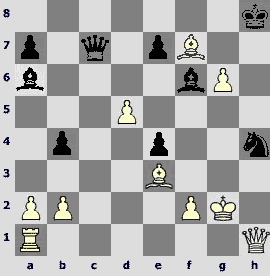


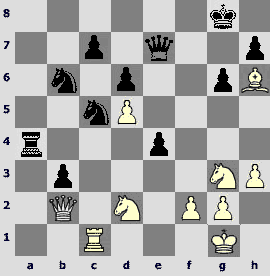


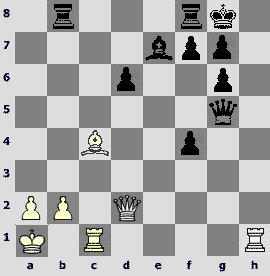


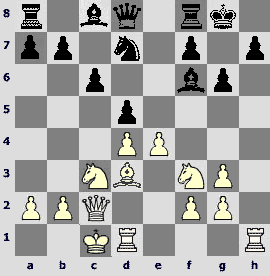




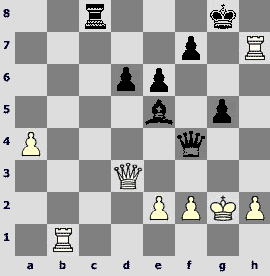

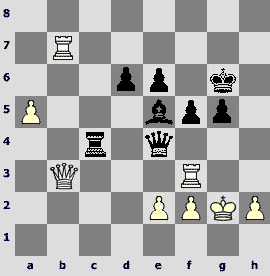





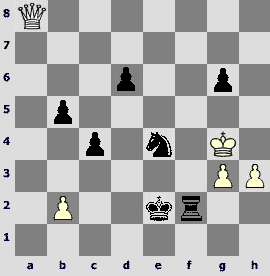








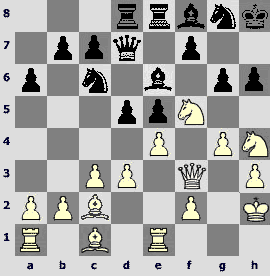



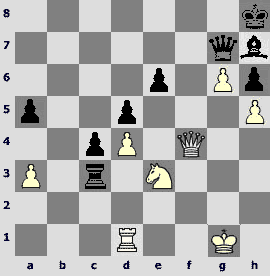















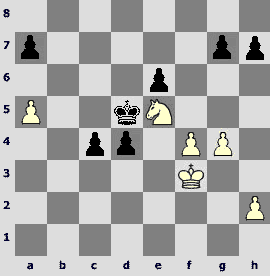


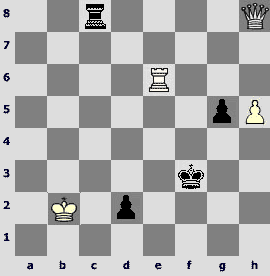





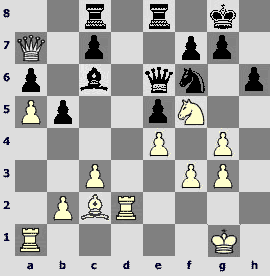

ALL ARTICLES BY AUTHOR

Discuss in forum